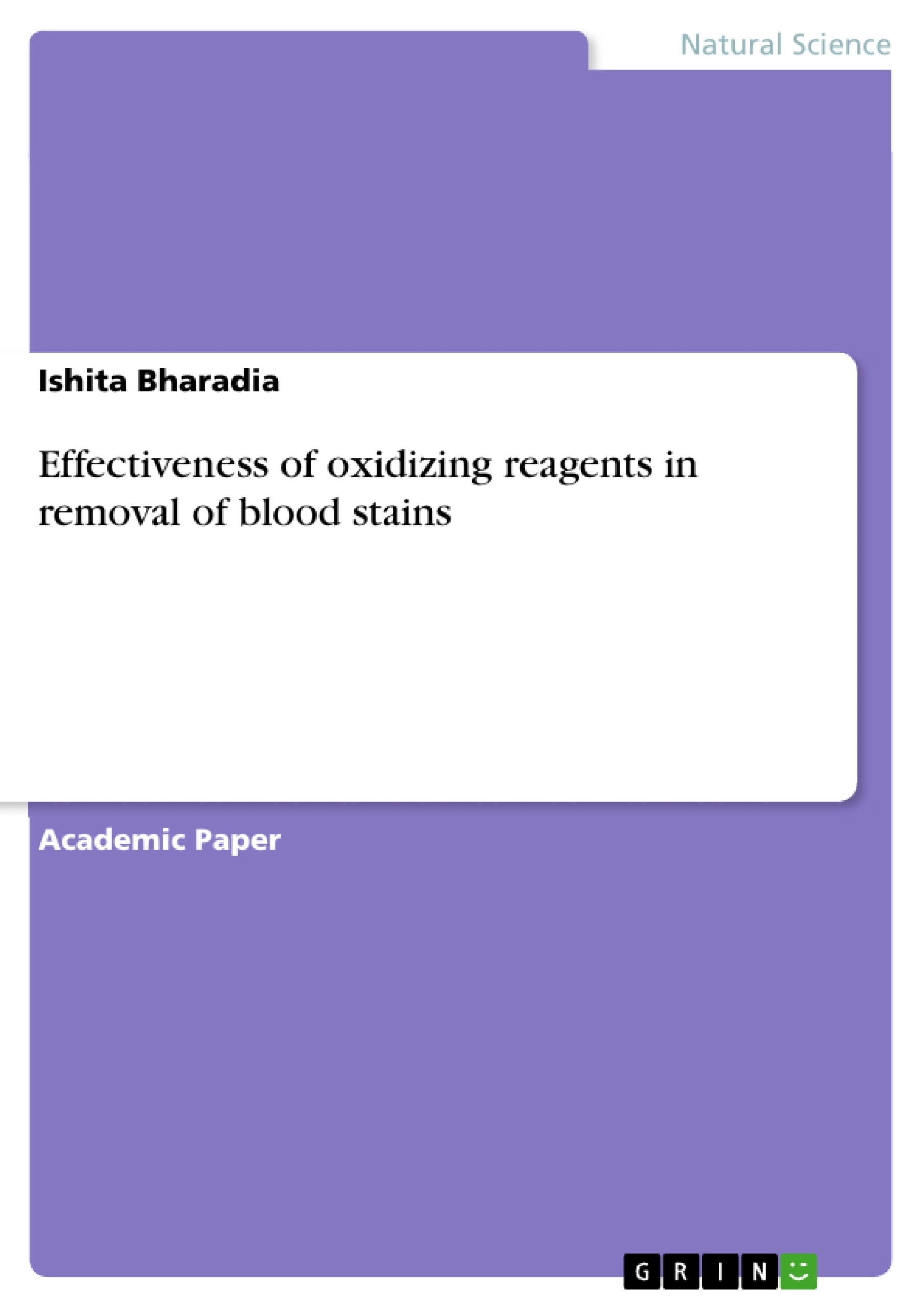This text is focussing on the effectiveness of oxidizing reagents in removal of blood stains. Adjustments, amendments, and concealing of the crime evidence have resulted in an increment in the world’s crime rate. One such recurring hindrance can be seen with the most vital forms of evidence; bloodstains. Bloodstains are considered to be one of the most difficult stains to remove and even after cleaning them off the clothes through the detergents available in the market, there are some colored traces left which do not disappear completely and can be detected.
Forensic scientists use luminol to detect bloodstains which when reacted with iron in blood stains exhibit chemiluminescence. This led to thinking of to what extent were these criminals able to manage the escape by washing the stains and hinder the evidence. After researching about the detergents from journals and websites like "The Science of Stain Removal, Study of Oxyper- H2O2, and Study of sodium perborate" and also studying the effect of various compounds present in them, it was found out that the active oxygen reagents were the sources through which bloodstain removal was possible. This helped in framing a research idea: To what extent does the change in mass of the oxidizing reagent, sodium perborate, sodium percarbonate and hydrogen peroxide found in detergents is effective in removing bloodstains, measured by spectrophotometric analysis of change in chemiluminescence intensity of luminol due to the oxidation of ferrous to ferric ions in stock solution containing oxidizing agents and iron solution imitating blood at room temperature (30°C)? In this essay, the correlation between the removal of the stains and the extent to which it depends on the amount of reagent was measured.
The decrease in chemiluminescence signifies the extent to which the stains are removed. On this basis, the cleansing action of various oxidizing agents like hydrogen peroxide, sodium perborate, and sodium percarbonate was compared. Seeing the competence of the strongest oxidizing reagent, it can be considered that this research will be useful for forensic science departments to detect the extent to which evidence was tried to be concealed as all the oxidizing agents contain H2O2 and even after washing the clothes, some content of H2O2 is left. It will also be valuable for the detergent manufacturers because, through this research, they will opt for a better oxidizing agent to yield a better cleansing action.
Inhaltsverzeichnis (Table of Contents)
- Topic
- Introduction
- Background information
- Oxidizing reagent
- Mechanism and Detection of Chemiluminescence
- Research Variables
- Expectation
- Chemicals required
- Apparatus required
- Cautionary Principles
- Methodology of Experimentation:
- Preparations of the chemicals
- Synthesizing of luminol stock solution
- Preparation of Iron stock solution imitating blood
- Synthesis of sodium per borate monohydrate
- Preparation of 3% H2O2
- Using the spectrophotometer
- Preparations of the chemicals
- Qualitative analysis
- Data collection and Graphical analysis
- Absorbance pattern shown by 0.1g of the reagents in visible light region
- Absorbance pattern shown by 0.2g of the reagents in visible light region
- Absorbance pattern shown by 0.3g of the reagents in visible light region
- Absorbance pattern shown by 0.4g of the reagents in visible light region
- Absorbance pattern shown by 0.5g of the reagents in visible light region
- Explanation of results and discussion
- Evaluation
- Limitations and improvements
- Future scope and Extension
- Bibliography
Zielsetzung und Themenschwerpunkte (Objectives and Key Themes)
This research investigates the effectiveness of oxidizing agents, commonly found in detergents, in removing bloodstains. The experiment aims to quantify the relationship between the mass of oxidizing agent used and the degree of stain removal, as measured by the change in chemiluminescence intensity of luminol. The study explores the oxidizing power of sodium per borate, sodium per carbonate, and hydrogen peroxide in removing the red pigment from bloodstains.
- The effectiveness of oxidizing agents in bloodstain removal.
- The relationship between the mass of oxidizing agent and the degree of stain removal.
- The comparative analysis of oxidizing strength between sodium per borate, sodium per carbonate, and hydrogen peroxide.
- The role of chemiluminescence and spectrophotometry in measuring stain removal.
- The potential application of this research in forensic science and detergent manufacturing.
Zusammenfassung der Kapitel (Chapter Summaries)
The introduction provides context for the research by highlighting the challenges associated with bloodstain removal and the importance of forensic investigations. The background information delves into the nature of oxidizing agents, their mechanism of action in stain removal, and the principles of chemiluminescence detection using luminol. The research methodology outlines the specific variables investigated, the expected outcomes, and the detailed procedures for preparing chemicals and conducting the spectrophotometric analysis. Subsequent chapters present and analyze the experimental data obtained for each oxidizing agent, comparing their effectiveness across varying masses. The discussion section interprets the results, emphasizing the trend of increasing absorbance with increased mass of oxidizing agent, highlighting the relative oxidizing strengths of the agents tested. The evaluation section reflects on the validity of the experimental design and identifies potential limitations and areas for improvement. Lastly, the study explores the future scope of the research, suggesting potential applications and extensions for further investigation.
Schlüsselwörter (Keywords)
Key themes and concepts explored in this research include oxidizing agents, bloodstain removal, chemiluminescence, spectrophotometry, luminol, ferrous ions, ferric ions, sodium per borate, sodium per carbonate, hydrogen peroxide, forensic science, and detergent manufacturing.
- Citation du texte
- Ishita Bharadia (Auteur), 2019, Effectiveness of oxidizing reagents in removal of blood stains, Munich, GRIN Verlag, https://www.grin.com/document/456043



